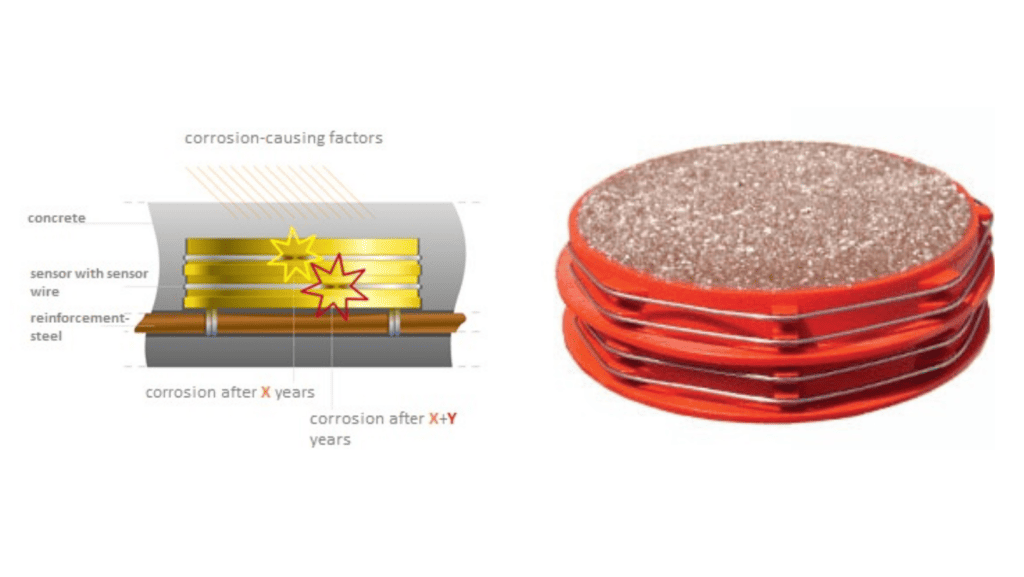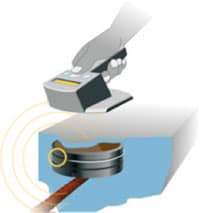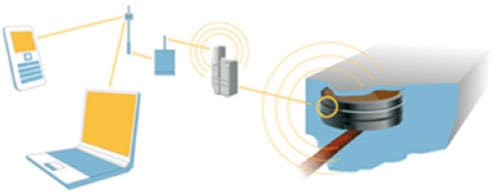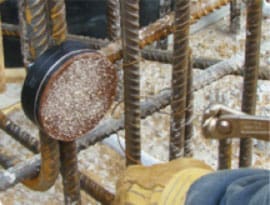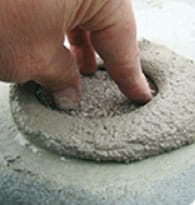CorroDec 2G
CorroDec 2G | Humidity & Corrosion Sensors
CorroDec2G
Corrosion / Humidity
The structural infrastructure must always meet requirements such as performance, stability and durability. These requirements will have a lasting effect on our mobility in the future.
The corrosion risk and the corrosion activity of the reinforcing steel largely define these requirements and are determined by various impact and material parameters.
Moisture and corrosion behavior are among the most important of these parameters in interaction with external environmental influences, cause invisible damage inside the concrete structure.
The early detection of corrosion activities inside the concrete structure essentially determine the costs for its maintenance and repair.

- Simple operation & evaluation
- Wireless & Powerless
- Remotely accessible
- Retrofittable
The system
Concrete plus steel - this combination stands for simple processing, variety of shapes, economic efficiency, and high load-bearing capacity in supporting structures in all construction areas.
However, it has a natural weak point:
The initially corrosion-resistant reinforcing steel loses its passive protective layer over time due to ageing and chemical influences. As a result, damage occurs, initially unnoticed, which can later endanger the load-bearing capacity of the entire structure. Once pitting, spalling and cracks have become visible, the remediation effort is already considerable.
Our unique cable- and energy-free early warning system, corroDec®2G, offers a simple and cost-effective solution here. Our sensors for corrosion, moisture or potential are inserted or retrofitted at the vulnerable points of the structure. Now the status can be recorded wirelessly at any time, and you receive valuable information about the structure's condition. As a result, you can take timely and targeted action. With our solution, you can sustainably secure the substance and value of your building and, if necessary, renovate it cost-efficiently. You can also effectively monitor the success of a repair measure.
Uncomplicated, cost-effective, and flexible.
CorroDec® sensors can be installed without great effort both before concreting and afterwards, with the help of a core hole drilling. Typical application areas are hydraulic structures, bridges, multi-storey car parks or shaft structures, etc.

CorroDec®2G – The unique monitoring solution for corrosion, moisture, potential
Identifies vulnerabilities before they become a danger.

- Simple operation & evaluation
- Wireless & Powerless
- Remotely accessible
- Retrofittable
- Preservation of the building fabric and thus sustainable safeguarding of investments
- Minimisation of maintenance and repair costs
- Proof of the quality of the structure or the success of a repair measure
- Significant contribution to the safety of the structure
System variants
CorroDec®2G offers a wide variety of sensor variants, expansion modules, installation options and interrogation paths.
It is, therefore, suitable for almost all types of structures and applications.
The sensors are passive, energy-free and have no cable connection to the outside world. In this way, we ensure an extremely long service life for the sensors and rule out the possibility of harmful factors entering the structure along a cable leading to the outside.
Sensor variants
The CorroDec®2G corrosion sensor is placed over the reinforcing steel before (using Rödel wire) or after concreting. A special sensor wire is routed around the sensor body, which is destroyed by corrosive influences. For the operator of this monitoring system, the following information is available after a query with the wireless reader:
- Sensor wire 1st level OK yes/no
- Sensor wire 2nd level OK yes/no
- Temperature in concrete
Special corrosion sensors are available for concrete structures up to 25m thick. The data is read with a reader – the function of the sensor can be queried before, during and after the concreting process. An optional remote query is also possible without being on-site.
The moisture sensor is used to measure the electrical conductivity and temperature within the concrete. The sensor consists of 2 rings (stainless steel) and is placed over the reinforcing steel before (using Rödel wire) or after concreting. It provides you with a reliable trend of how the moisture in the structure is developing.
Special moisture sensors are available for concrete structures up to 25m thick. The data is read with a reader – the function of the sensor can be queried before, during and after the concreting process. An optional remote query is also possible without being on-site.
Depending on the installation scenario, the standard reading range between reader and sensor (standard reader: up to 10cm / advanced reader: up to 40cm) may not be sufficient to overcome extreme concrete/material overlaps, for example. For this purpose, we have developed an external sensor antenna connected to the sensor unit by cable but also completely embedded in the concrete/material. This can be up to 25m away from the sensor itself. Thus, even installation depths of the sensor of up to 25.45m are possible.
Even in cases where the sensors are located in inaccessible places (e.g. in the middle of the carriageway, foundations, bridge substructure, etc.), convenient reading is possible without additional effort and at a safe, easily accessible location.
This eliminates the need for time-consuming and dangerous lane closures or special crane operations, e.g., inspection. Even in the area of hydraulic structures, a readout is thus possible “on dry feet.”
Query variants
Our sensors are passive and without energy. The component is only supplied with energy through interrogation by means of readers; the status of the system (self-test) and the sensor wire are evaluated fully automatically and signalled on the reader. By means of software, this data can be documented and conveniently visualised. The data is read out on-site; the reading range depends on the type of reader used (standard reader: up to 10cm / advanced reader: up to 40cm). In addition, our external antenna unit can be used for greater installation depths, enabling installations up to 25 metres.
As an alternative to on-site reading, the sensors can be queried with the help of the system extension for remote reading, which is attached to the structure within the reading range. Furthermore, via our “BS2-Universal Monitoring System“, this data can be visualised and alerted via the internet or directly connected to an existing internal monitoring system.
This means that the structure’s condition at the neuralgic points can be called up remotely at any time.
Installation variants
Fixing of the corrosion sensor above the reinforcement (corrosion attack from above), backfilling adapted to the ambient conditions and in accordance with the standard with subsequent compaction + post-treatment.
A minimum concrete cover of 15 mm from the upper edge of the sensor must be observed for a quality of C20/25. For higher concrete strength classes from C40/45, the value can be reduced by 5 mm.

Fixing of the sensor by means of a core hole drilling, filling with coupling mortar, and finishing (depending on the position) with a mechanical sealing system or shrinkage-free plastic-modified mortar. The subsequent mechanical load situation and the corresponding after-treatment of the surface must be observed in accordance with the current regulations. In the case of a final coating, the coupling mortar can be applied to the surface.
Readers & Software
The CorroDec®2G sensor system series is based on the RFID principle. This means that the sensors do not require any power supply or data transfer cables. Instead, the energy for the sensors is supplied by the reader. Furthermore, the data is transferred simultaneously when a sensor is activated. Therefore, it takes only 3 to 5 seconds to collect and evaluate the data of a sensor.
The reader meets the following requirements:
- High mechanical stability
- Small and handy
- One-handed operation
- Standard reading range up to 10 cm
- Advanced reading range up to 45 cm
- Permanent data storage of up to 1,000 sensors
- Wireless transmission (WLAN) of data to a computer
- Immediate display of the detected data regarding the status (sensor detected + sensor OK)

The functionality of the sensors can be checked with the reader before, during and after installation.
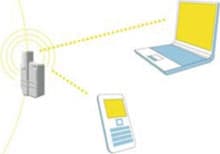
Our external antenna unit can be used for greater installation depths, allowing installations up to 25 metres.
Fields of application / References
Our CorroDec®2G technology can be used in almost all structures and is versatilely adaptable; the following areas of application serve as examples:

New construction: e.g. no surface protection system when using a corrosion sensor/moisture sensor
Download case study multi-storey car park (new construction)
Repair: e.g. coating incl. corrosion sensor/moisture sensor
Download case study car park (repair)
New construction: e.g. installation in the tendon area and in the drainage area
Repair: e.g. installation in the area of the tendons and in the area of the drainage – Monitoring residual risk
Download the case study bridge
New construction: e.g. monitoring corrosion risk from the outside
New construction: e.g. installation of sensors in the portal area (de-icing salt influence) // installation in case of massive sulphate load Maintenance: e.g. monitoring of residual risk with corrosion sensor in the portal area
Download the case study Tunnel
New construction: e.g. installation of a corrosion sensor in inaccessible places in the event of sulphate contamination
Download the Sewage Treatment Plant Case Study
Research & Development
The company BS2 Sicherheitssysteme has successfully completed the development of the 2nd generation of corrosion sensors. This development was funded by the AIF and the Federal Ministry of Economics within the framework of the Central Innovation Programme for SMEs.
The further development of the old system was necessary because the system cannot be remotely interrogated, and use in special applications (e.g. bored piles) is not feasible due to the technology used.
The new system has the following features:
- Immediate information about the condition of the sensor wire already when detecting (recognising) the corrosion sensor (with handheld reader or mobile reader)
- No direct contact with the surface necessary - Reaches up to 50 cm
- Can be integrated into remote network systems
- More flexible application possibilities (larger surface effect, special geometries, etc.)
- Incl. residual life assessment of the structure
Concrete system testing is carried out in Germany (BÜW) and referenced in Switzerland (TFB).

Forecast model for structures
Monitoring solutions provide valuable data on the structure's condition and detect possible damaging factors in good time. Furthermore, this data can also be a tool for creating a prognosis model, which provides information about the remaining service life of a structure, for example.
Together with the Institut für Begutachtung und Überwachung von Baustoffen (BüW) in Herzogenrath, such a model was developed within the framework of an R&D project funded by the Federal Ministry of Economics.
We will be happy to answer any questions you may have.

Let us advise you!
Benedikt Seuss is your personal contact and advisor in the field of intelligent concrete structures.
